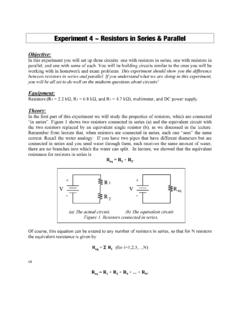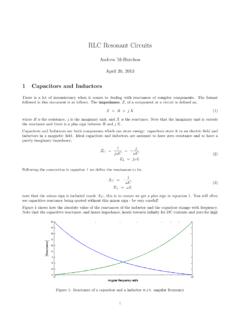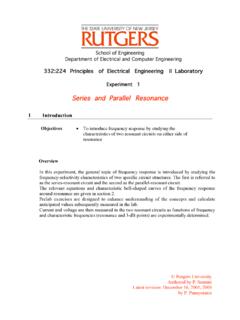Transcription of Strings, Parallel Cells, and Parallel Strings - Orion BMS
1 1 Strings , Parallel cells , and Parallel Strings Whenever possible, using a single string of lithium cells is usually the preferred configuration for a lithium ion battery pack as it is the lowest cost and simplest. However, sometimes it may be necessary to use multiple Strings of cells . Here are a few reasons that Parallel Strings may be necessary: 1. Redundancy (only for specific applications) 2. Hot swap capability (UPS applications, telcom, scalable systems, etc.) 3. When you must use a particular type of cell which is only available in a module with several cells in a string with no means of directly paralleling the cells . Important Note: Due to the risks of Parallel Strings , additional external safety systems must be used in conjunction with the BMS when the Orion BMS or Orion Jr. BMS are used with Parallel Strings . Electrical engineering is required to use the Orion BMS or Orion Jr. BMS with Parallel Strings , and this work must be performed by an electrical engineer who is trained in working with and understands the risks of paralleled lithium ion batteries.
2 Do not attempt to use Parallel Strings without proper training. 2 Strings , Parallel cells , and Parallel Strings .. 1 Standard Battery Configuration .. 3 Standard Paralleled Cell Configuration .. 4 Paralleled string Configuration .. 6 Difficulties with Parallel Strings .. 7 Major problems with Parallel Strings .. 7 Eddy currents) .. 7 Lower maximum usable capacity) .. 8 Exponential impact of one bad cell) .. 8 Inrush currents when Strings first paralleled) .. 8 Less significant issues .. 9 Lower maximum power) .. 9 Cascading shutdown) .. 9 Difficulty calculating amperage limits & state of charge) .. 9 Individual control of charge and discharge currents) .. 9 Possibility of interrupted charge power).. 9 Parallel string Topologies .. 10 Standard paralleled Strings with just contactors .. 11 Paralleled Strings with two diodes and two contactors .. 13 Paralleled Strings with two separate DC busses .. 14 Parallel Strings with 1 charger per string and single discharge DC bus.
3 15 string A / string B switch .. 16 Micro-inverters or DC:DC converters .. 17 3 Standard Battery Configuration Below is a diagram of a standard 8 cell lithium ion string . Unless there are specific reasons for doing otherwise, this is the most desirable and simplest configuration: In the above example, 8 cells are configured in a single string . This is an 8S1P configuration. The 8S indicates that there are 8 cells in series and the 1P indicates that there are no paralleled cells . If each cell is 10 amp hours and volts, the battery pack above would be 10 amp hours and volts ( volts x 8 cells ). For this setup, a BMS capable of monitoring 8 cells in series is necessary. 4 Standard Paralleled Cell Configuration Lithium cells can almost always be paralleled directly together to essentially create a larger cell. This is useful when a cell manufacture does not manufacture the correct size cell needed or when there are certain physical constraints.
4 In some cases paralleling multiple smaller cells can also reduce the overall internal resistance and increase the power capabilities of the pack. The method of paralleling cells directly together as shown in the diagram below is generally the simplest and most preferred method of increasing the capacity of the battery pack. In the above configuration, the amp hour capacity is increased without increasing the pack voltage. Even though 8 cells are used, because each cell is paralleled with one other cell, the BMS can treat each pair of cells as a single cell. This allows the designer to use a smaller BMS. The above configuration is a 4S2P configuration. The 2P indicates that there are 2 cells paralleled together, where-as the 4S indicates that there are 4 of these pairs in series. If each cell is 10 amp hours and , the battery pack above would be 20 amp hours (10 amp hours x 2 cells ) and volts ( volts x 4 pairs). Even though there are twice the number of cells in this configuration, for this setup, a BMS capable of monitoring only 4 cells is necessary.
5 In the case of cells which are Parallel together and then assembled into a single string , as shown above, the BMS will see the two paralleled cells as a sing cell with twice the capacity and half the internal resistance of a single cell. Since there is a busbar between the two positive and two negative terminals of the batteries, the voltage of both cells is forced to be equal. 5 Therefore, monitoring the voltage of either cell will show the same results (less the very negligible difference in voltage caused by voltage drop on the busbar). In the event that one of the cells develops a reduced capacity or high resistance (as is typical for aged or failed cells ), the stronger cell will take more of the load and essentially prop up the weaker cell. In that event, the BMS is able to see a decrease in the overall capacity or an overall increase in resistance. With two cells paralleled together, a single weak cell can affect the resistance up to 50% and the capacity up to 50%.
6 If three cells are paralleled, a single bad cell can affect the resistance and capacity of the total paralleled block up to 33% (with four cells paralleled, up to 25%, and so forth). As more cells are paralleled, a single failure becomes more difficult to detect, but redundancy is also increased since a single cell failure will have less of an impact on the overall performance of the battery. cells directly paralleled with each other will automatically balance each other since they are permanently connected. Note: While most lithium batteries can be directly paralleled together, check with the cell manufacturer to ensure that the cells can be safely paralleled and to see if there are any specific requirements for the specific cells used. In some cases (such as with some 18650 style cells ), cell manufacturers may require individual fuses or fusible link wire to prevent over current through a single cell in the event of a cell failure or an internal short within a cell.
7 Consult with the cell manufacturer to determine if such a design is necessary. 6 Paralleled string Configuration Paralleling Strings together greatly increases the complexity of managing the battery pack and should be avoided unless there is a specific reason to use this configuration. In this setup, each string must essentially be treated as its own battery pack for a variety of reasons. In a below example, 2 Strings of 8 cells each are placed in Parallel . In the above configuration, two 8S1P Strings are paralleled together. With perfectly matched and perfectly balanced 10 amp hour, volt cells , the above configuration would have a total of 20 amp hours and volts. However, in reality, the total usable capacity of this pack will be less than 20 amp hours. Additionally, because no two cells are exactly the same, different currents will flow through each battery pack due to differing internal resistances, creating difference in state of charge between the two Strings .
8 Therefore, for full management with multiple Strings , one BMS unit must be used per string , and in some cases, a master controller must be used to manage the whole pack. In the above example, two BMS units, each capable of managing 8 cells in series must be used in conjunction with at least one contactor per string that automatically disconnects the string in the event of a failure, over-charge, over-discharge, or other fault. This is essential to prevent the Strings from runaway in the event of imbalance between cells or a cell failure. Never leave two lithium ion Strings permanently paralleled or leave multiple Strings paralleled without monitoring systems and a means of automatic disconnection. As always with any safety critical circuit, always use multiple redundant and independent shutoff systems. 7 Difficulties with Parallel Strings While it may seem that paralleling multiple Strings would increase the overall reliability of a battery pack design, in reality, the opposite is usually true.
9 Unlike lead-acid cells which are commonly assembled in Parallel Strings , lithium cells are very intolerant of over charge and over discharge. Since lithium cells must be managed on a cell level, Parallel lithium Strings dramatically increase the complexity and cost of the battery management and introduce many additional points of failure and failure modes not found with a single string . A Parallel string topology almost always leads to a lower overall usable capacity and lower maximum power output. A single weak or bad cell can exponentially lower the capacity of the entire battery pack. A properly engineered system can improve the overall reliability, but only when additional equipment and significant engineering time is invested. Whenever possible, a single string set-up should be considered. Major problems with Parallel Strings Eddy currents) When two or more Strings are paralleled together, currents will flow between the Strings .
10 These currents form due to differences in the total pack voltage between Strings . The amount of current that flows is determined by the difference in total string voltages, resistance of each string , and the characteristics of the cells . With these currents, it is possible for one string to force charge a second string , which can lead to over-charging or over-discharging individual cells . A low capacity cell or a faulty cell can cause the force charging of an entire string which may result in over-charge and/or over-discharge. While it seems counter-intuitive, it is possible (in fact, likely) when the charger shuts off due to a fully charged cell in one string , that string may continue to be charged by another Parallel string (the same principal applies to discharge). For example, if string A contains a cell which is fully charged, it is possible that current could flow from a second paralleled string B into string A. This would happen every time the average cell voltage in string B was higher than the average cell voltage in string A, even though string A has a cell which has become fully charged (or fully discharged.)







